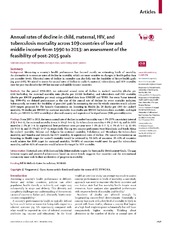Annual rates of decline in child, maternal, HIV, and tuberculosis mortality across 109 countries of low and middle income from 1990 to 2013: An assessment of the feasibility of post-2015 goals
Peer reviewed, Journal article
Published version
Date
2014-12Metadata
Show full item recordCollections
Original version
https://doi.org/10.1016/s2214-109x(14)70316-xAbstract
Background Measuring a country’s health performance has focused mostly on estimating levels of mortality. An alternative is to measure rates of decline in mortality, which are more sensitive to changes in health policy than are mortality levels. Historical rates of decline in mortality can also help test the feasibility of future health goals (eg, post-2015). We aimed to assess the annual rates of decline in under-5, maternal, tuberculosis, and HIV mortality over the past two decades for 109 low-income and middle-income countries. Methods For the period 1990–2013, we estimated annual rates of decline in under-5 mortality (deaths per 1000 livebirths), the maternal mortality ratio (deaths per 100 000 livebirths), and tuberculosis and HIV mortality (deaths per 100 000 population per year) using published data from UNICEF and WHO. For every 5-year interval (eg, 1990–95), we defi ned performance as the size of the annual rate of decline for every mortality indicator. Subsequently, we tested the feasibility of post-2015 goals by estimating the year by which countries would achieve 2030 targets proposed by The Lancet’s Commission on Investing in Health (ie, 20 deaths per 1000 for under-5 mortality, 94 deaths per 100 000 for maternal mortality, four deaths per 100 000 for tuberculosis mortality, and eight deaths per 100 000 for HIV mortality) at observed country and aspirational best-performer (90th percentile) rates. Findings From 2005 to 2013, the mean annual rate of decline in under-5 mortality was 4·3% (95% uncertainty interval [UI] 3·9–4·6), for maternal mortality it was 3·3% (2·5–4·1), for tuberculosis mortality 4·1% (2·8–5·4), and for HIV mortality 2·2% (0·1–4·3); aspirational best-performer rates per year were 7·1% (6·8–7·5), 6·3% (5·5–7·1), 12·8% (11·5–14·1), and 15·3% (13·2–17·4), respectively. The top two country performers were Macedonia and South Africa for under-5 mortality, Belarus and Bulgaria for maternal mortality, Uzbekistan and Macedonia for tuberculosis mortality, and Namibia and Rwanda for HIV mortality. At aspirational rates of decline, The Lancet’s Commission on Investing in Health target for under-5 mortality would be achieved by 50–64% of countries, 35–41% of countries would achieve the 2030 target for maternal mortality, 74–90% of countries would meet the goal for tuberculosis mortality, and 66–82% of countries would achieve the target for HIV mortality. Interpretation Historical rates of decline can help defi ne realistic targets for Sustainable Development Goals. The gap between targets and projected achievement based on recent trends suggests that countries and the international community must seek further acceleration of progress in mortality.

